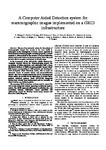A Computer Aided Detection system for mammographic images implemented on a GRID infrastructure
| dc.contributor.author | Bottigli, U | en |
| dc.contributor.author | Cerello, P | en |
| dc.contributor.author | Delogu, P | en |
| dc.contributor.author | Fantacci, ME | en |
| dc.contributor.author | Fauci, F | en |
| dc.contributor.author | Forni, G | en |
| dc.contributor.author | Golosio, B | en |
| dc.contributor.author | Indovina, PL | en |
| dc.contributor.author | Lauria, A | en |
| dc.contributor.author | Torres, EL | en |
| dc.contributor.author | Magro, R | en |
| dc.contributor.author | Masala, GL | en |
| dc.contributor.author | Oliva, P | en |
| dc.contributor.author | Palmiero, R | en |
| dc.contributor.author | Raso, G | en |
| dc.contributor.author | Retico, A | en |
| dc.contributor.author | Stefanini, A | en |
| dc.contributor.author | Stumbo, S | en |
| dc.contributor.author | Tangaro, S | en |
| dc.date.accessioned | 2016-11-11T10:26:30Z | |
| dc.date.available | 2016-11-11T10:26:30Z | |
| dc.identifier.uri | http://hdl.handle.net/10026.1/6723 | |
| dc.description | 5 pages, 5 figures, to appear in the Proceedings of the 13th IEEE-NPSS Real Time Conference 2003, Montreal, Canada, May 18-23 2003 | en |
| dc.description.abstract |
The use of an automatic system for the analysis of mammographic images has proven to be very useful to radiologists in the investigation of breast cancer, especially in the framework of mammographic-screening programs. A breast neoplasia is often marked by the presence of microcalcification clusters and massive lesions in the mammogram: hence the need for tools able to recognize such lesions at an early stage. In the framework of the GPCALMA (GRID Platform for Computer Assisted Library for MAmmography) project, the co-working of italian physicists and radiologists built a large distributed database of digitized mammographic images (about 5500 images corresponding to 1650 patients) and developed a CAD (Computer Aided Detection) system, able to make an automatic search of massive lesions and microcalcification clusters. The CAD is implemented in the GPCALMA integrated station, which can be used also for digitization, as archive and to perform statistical analyses. Some GPCALMA integrated stations have already been implemented and are currently on clinical trial in some italian hospitals. The emerging GRID technology can been used to connect the GPCALMA integrated stations operating in different medical centers. The GRID approach will support an effective tele- and co-working between radiologists, cancer specialists and epidemiology experts by allowing remote image analysis and interactive online diagnosis. | en |
| dc.language.iso | en | en |
| dc.subject | physics.med-ph | en |
| dc.subject | physics.med-ph | en |
| dc.title | A Computer Aided Detection system for mammographic images implemented on a GRID infrastructure | en |
| dc.type | Conference Contribution | |
| plymouth.author-url | http://arxiv.org/abs/physics/0306198v1 | en |
| plymouth.organisational-group | /Plymouth | |
| plymouth.organisational-group | /Plymouth/Faculty of Science and Engineering | |
| plymouth.organisational-group | /Plymouth/REF 2021 Researchers by UoA | |
| plymouth.organisational-group | /Plymouth/REF 2021 Researchers by UoA/UoA11 Computer Science and Informatics | |
| dcterms.dateAccepted | 2003-01-01 | en |
| dc.rights.embargoperiod | Not known | en |
| rioxxterms.licenseref.uri | http://www.rioxx.net/licenses/all-rights-reserved | en |
| rioxxterms.type | Conference Paper/Proceeding/Abstract | en |


